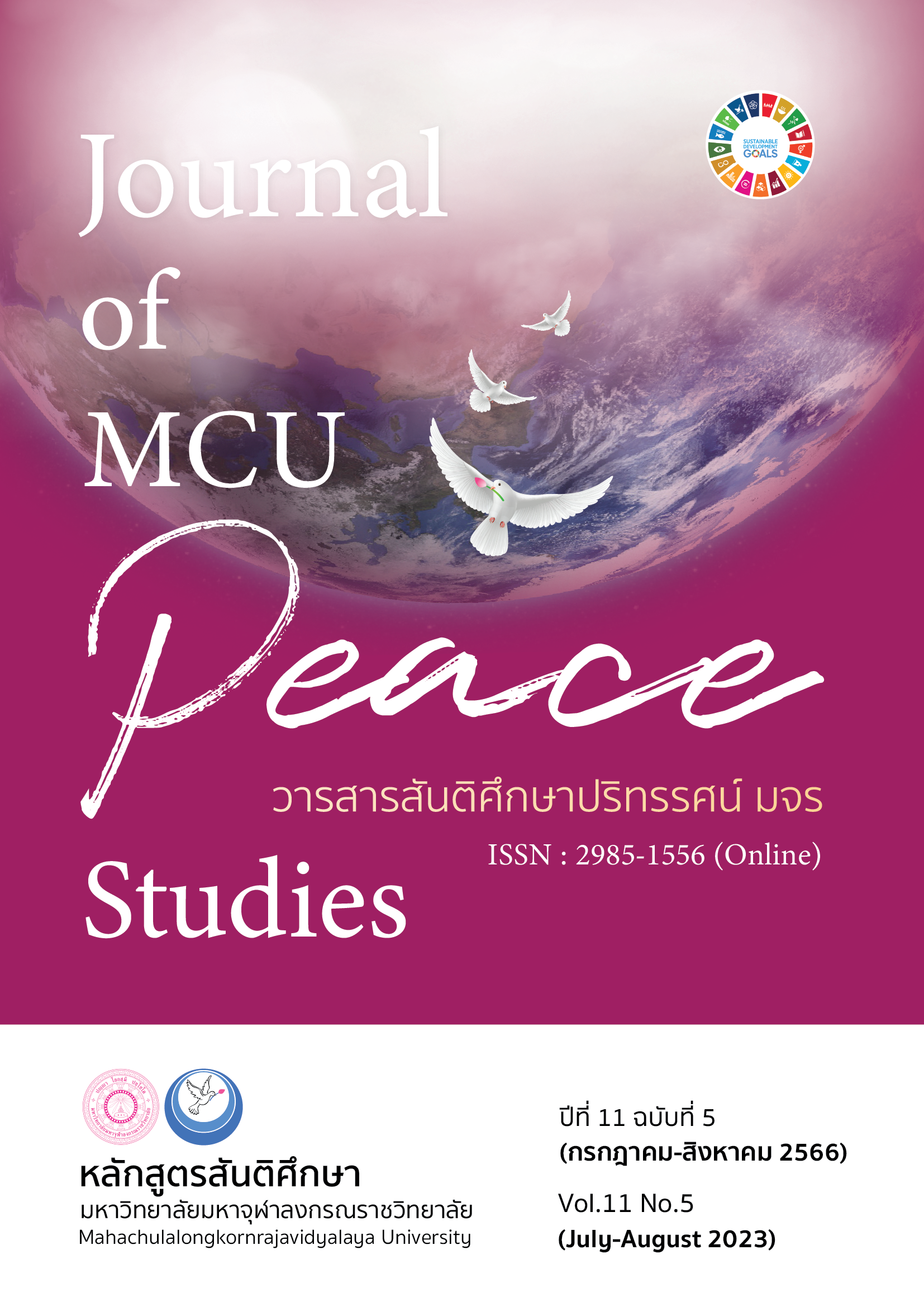การพัฒนาผู้ประนีประนอมตื่นรู้ต้นแบบโดยพุทธสันติวิธี
Main Article Content
บทคัดย่อ
บทความวิจัยนี้ มีวัตถุประสงค์ 1) เพื่อศึกษาวิเคราะห์ บริบท สภาพปัญหา ความต้องการจำเป็นการพัฒนาผู้ประนีประนอมตื่นรู้ต้นแบบโดยสันติวิธี 2) เพื่อศึกษาวิเคราะห์พุทธสันติวิธีที่เอื้อต่อการพัฒนาผู้ประนีประนอมตื่นรู้ต้นแบบโดยพุทธสันติวิธี 3) เพื่อพัฒนาและนำเสนอผู้ประนีประนอมตื่นรู้ต้นแบบโดยพุทธสันติวิธี เป็นงานวิจัยตามอริยสัจโมเดลสอดคล้องกับการวิจัยเชิงปฏิบัติการแบบมีส่วนร่วม กลุ่มผู้ให้ข้อมูลสำคัญ ได้แก่ 1) นักวิชาการด้านพุทธศาสนา/สันติวิธี จำนวน 6 รูป/คน 2) ด้านผู้ประนีประนอม 5 คน 3) ด้านผู้นำองค์กรและศูนย์ไกล่เกลี่ยประจำศาล 5 คน 4)ด้านกระบวนการนักออกแบบการฝึกอบรม 5 คน 5) ด้านผู้กำกับเชิงนโยบายผู้ประนีประนอม 5 ท่าน โดยการสัมภาษณ์เชิงลึกแบบเจาะจง และนำมาวิเคราะห์อธิบายเชิงพรรณนา
ผลการวิจัยพบว่า 1) สภาพปัญหาของผู้ประนีประนอมเกิดจากอคติ มีผลให้เกิดการตีความหมายที่ผิดเพี้ยนไป ปัญหาการตีความที่มีอคติลำเอียง มีทิฐิ มานะ อัตตา ตัวตนสูง Ego ที่เกิดขึ้น จึงจำเป็นต้องมี การพัฒนาองค์ความรู้ทั้งภายในและภายนอกควบคู่กัน เพื่อการตื่นรู้เป็นปัจจุบันเป็นผู้ประนีประนอมตื่นรู้ต้นแบบต่อไป 2) หลักสติปัฏฐาน 4 เป็นพุทธสันติวิธีที่เอื้อต่อการพัฒนาผู้ประนีประนอมตื่นรู้ต้นแบบเป็นหลักธรรมในการพัฒนาผู้ประนีประนอมให้เกิดสติ สัมปชัญญะ รู้ตัวทั่วพร้อมในพระพุทธศาสนาเน้นการพัฒนาอบรมเชิงปฏิบัติการแบบมีส่วนร่วมอย่างต่อเนื่องเพื่อพัฒนาผู้ประนีประนอมตื่นรู้ต้นแบบอย่างยั่งยืน 3) การพัฒนาผู้ประนีประนอมตื่นรู้ต้นแบบโดยพุทธสันติวิธี มีการพัฒนาภายในจิตใจ ด้วยการเจริญสติปัฏฐาน 4 ดูกาย อิริยาบท ยืน เดิน นั่ง นอน ดูเวทนา รู้เวทนา สุข ทุกข์ เฉยๆ รู้จิต ตื่นรู้เข้าใจธรรมที่เป็นกุศล อกุศล มีจิตผ่องใสรู้และเข้าใจอริยสัจจ์ 4 มากขึ้น โดยมีการพัฒนาด้านพฤติภาพตามโมเดล 5 ด้าน ใช้หลักพุทธสันติวิธีบูรณาการกับศาสตร์สมัยใหม่พัฒนาอบรมเชิงปฏิบัติถูกต้องเกิดการตื่นรู้ เป็นการเรียนรู้สู่ภายในสู่ภายนอกและภายนอกสู่ภายในด้วยการลงมือปฏิบัติ
Article Details

This work is licensed under a Creative Commons Attribution-NonCommercial-NoDerivatives 4.0 International License.
ทัศนะและความคิดเห็นที่ปรากฏในบทความในวารสาร ถือเป็นความรับผิดชอบของผู้เขียนบทความนั้น และไม่ถือเป็นทัศนะและความรับผิดชอบของกองบรรณาธิการ ยินยอมว่าบทความเป็นลิขสิทธิ์ของวารสาร
References
Freud, S. (2015). Psychoanalytic Theory. Retrieved November 20, 2022, from http://nukjit.blogspot.com/
Mahachulalongkornrajavidyalaya University. (1996). Thai Tripitakas. Bangkok: MCU Press.
Office Of the Judiciary. (2022). Court of Justice Strategic Plan (B.E. 2565-2568). Retrieved November 15, 2022, from https://oppb.coj.go.th/th/file/get/file/202110054c829232e66e028e524f2db30e60e634131014.pdf
Office of the National Economic and Social Development Council on NESDC. (2022). The 13th National Development Plan (2023 – 2027). Retrieved December 2, 2022, from https://www.nesdc.go.th/download/Plan13/Doc/Plan13_DraftFinal.pdf
Phra Adisuk Wachirapunyoo (Pimnon), & Khuntong, A. (2014). The Qualifications of the Mediator in the Integrated Buddhist Perspective. (Master’s Thesis). Mahachulalongkornrajavidyalaya University. Ayutthaya.
Phra Bhramagunabhorn (P. A. Payutto). (2008). How to Develop People. Nakhon Pathom: Buddhadhamma Foundation, Wat Yanwesakawan.
Phra Pisal Visalo. (2016). “What is Awakening?” in Awakening. Bangkok: Sook Publishing.
Phrakhanong Criminal Court. (2018). History/General Information of the Agency. Retrieved November 15, 2022, from https://crimpkc.coj.go.th/th/content/page/index/id/56
Phramaha Hansa Dhammahaso (2018). Buddhist Peaceful Means: An Application of Principles and Tools to Conflict Management. Bangkok: Prayoonsanthai Printing Limited Partnership.
Phramaha Hunsa Dhammahaso (Nithibunyakorn). (2005). A Pattern of Conflict Management by Buddhist Peaceful Means: A Critical Study of Mae Ta Chang Watershed Chiang Mai. (Doctoral Dissertation). Mahachulalongkornrajavidyalaya University. Ayutthaya.
Phramaha Pornchai Chandhadhammo, & Phramaha Mit Thitapanyo. (2020). The Right View for Solving Social Problems in Contemporary Society. Dhammathas Academic Journal, 20(3), 217-226.
Rungrueangphadung, Ph., & Phramaha Hansa Dhammahaso. (2019). An Integration of Subpaya Principle to Enhance the Effectiveness of Meditation. Journal of MCU Peace Studies, 7(Supplement Issue), S240-S252.
Somdet Phra Buddhaghosacariya (P. A. Payutto). (2016). Dictionary of Buddhism. (34th ed.). Bangkok: Peace Education Foundation.
Thongbun, A. (2018). How to Resolve the Conflict with Buddhist Harmony in Thai Society. Mahachula Academic Journal, 1(2), 24-34.

